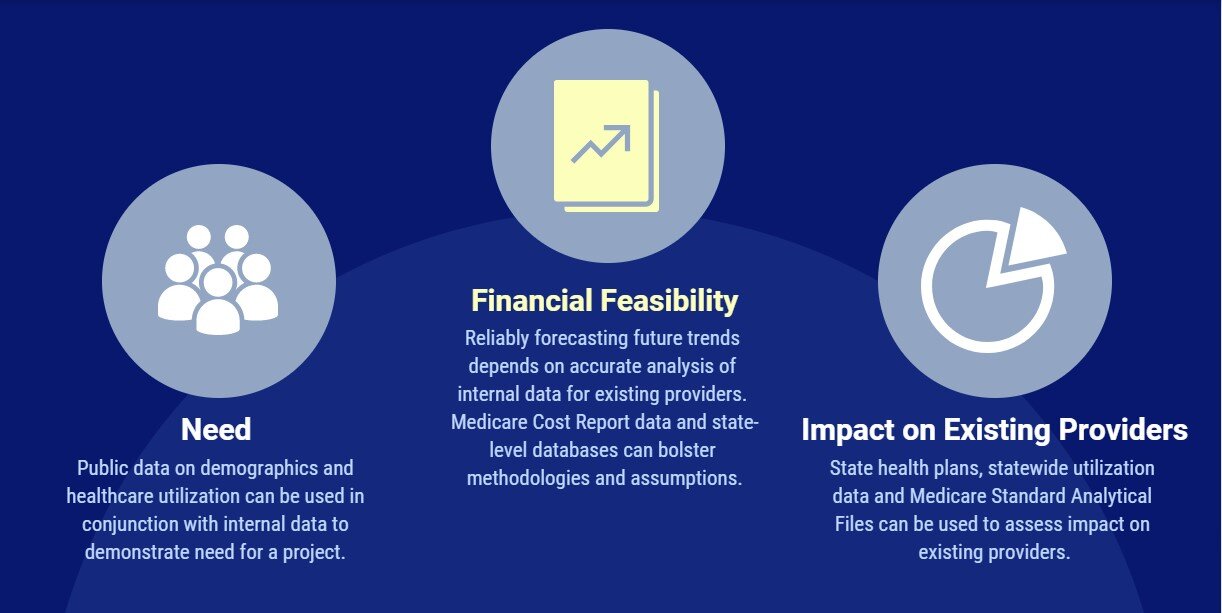Author
Author: Robin B. Gage, MBA, MHA
Certificate of Need (CON) requirements vary by state, but many require applications to address three main topics: need, financial feasibility, and impact on existing providers. This is the second in a three-part series on these topics. This part discusses data sources to address the financial feasibility of a CON-reviewable project.

Demonstrating a project’s financial feasibility is a core requirement for most CON-reviewable projects. An applicant first must prove it has the capital to develop and initiate the proposed project. This is sometimes called “short-term financial feasibility.” Most states require applicants to prove “long-term financial feasibility” with utilization and financial projections for the first two or three years of operations. The state agency will determine if the applicant’s projections reasonably show the project’s revenues will exceed its expenses within a prescribed period. In a competitive review or an administrative hearing, other applicants and existing providers may challenge volume projections and financial assumptions. Having a conservative, well-documented basis for both is crucial to an application’s success. Below, we discuss several data sources useful in determining the financial feasibility of a project.
Internal Data
For existing providers, internal data are extremely useful in demonstrating the financial feasibility of a project. Internal data are more detailed than data available from public sources. These are examples of internal data sources and how they can be used.
- Claims data from provider billing software allows detailed analysis of charges and payments by procedure and diagnosis codes, payor and performing physician. The detailed data can be the basis for projecting future charges and payments for the planned services. Analysis by procedure and diagnosis data elements shows how service line growth will affect profitability.
- Audited financial statements, including a balance sheet, statement of income and expenses with supporting schedules, statement of changes in financial position, notes to the statement and auditor’s letter are often required in CON applications. They show the applicant’s or parent company’s financial health and ability to fund the proposed project.
Applicants usually must have a letter showing availability of funds to the project from a lender or from the applicant’s treasurer or CFO. If the project involves construction, a letter from the architect verifying the estimated cost is often required.
Public Data Sources
A competing applicant or an existing provider opposing a CON application will find several publicly data sources helpful to challenge utilization and financial projections.
Federal Data
Medicare Standard Analytical Files (SAFs) are published by the Centers for Medicare and Medicaid Services (CMS) and contain all fee-for-service Medicare claims for services rendered during a calendar year. Data are organized at the claim level and data sets for inpatient and outpatient hospital services, home health agencies, hospices, skilled nursing facilities and durable medical equipment (DME). SAFs have data on billed charges by procedure that can validate the reasonableness of projected gross revenues and charges SAF data sets are also available for professional services. Depending on the provider type, data elements available in the files include:
- Unique beneficiary identifier
- Patient demographic information (county of residence, age group, sex, and race)
- Place of service and attending physician identification
- Diagnosis codes
- Procedure codes
- Charges
- Medicare allowed amount
- Patient discharge status
Medicare Cost Reports are submitted annually by hospitals, nursing homes, hospices, and home health agencies. They contain data on facility characteristics, utilization, staffing, operating costs, charges, and revenue. CMS publishes a subset of the cost report data in the Healthcare Provider Cost Reporting Information System (HCRIS) for public use. Cost report data are useful to compare revenue and expenses among facilities.
IRS Form 990 has data on executive compensation of private tax-exempt providers, such as hospitals, hospices, and nursing homes. These forms also have financial information on any community benefits. They may be issues in competitive reviews. They may also be issues when an existing provider objects that a new provider will adversely affect is ability to provide charity care or other community benefits.
State Data
Facility level volume and charge data are available in some states, but their public availability varies considerably. These data provide information on charges, which can compare an applicant’s charges to area providers, or to critique the proposed charges in the application. Some states, like North Carolina, require hospitals to report claims-level utilization data to a third-party organization that compiles the data. The data are not available to the general public, but is available to hospitals that report into the database. However, many basic NC hospital discharge statistics are now available through a query tool on HCUPnet. HCUPnet data are publicly available at no charge. Other states, like Florida, make discharge data for hospitals, emergency departments, and rehabilitation providers publicly available.
According to the National Association of Health Data Organizations (NAHDO), seventeen states have implemented or developed an All Payer Claims Database (APCD). APCDs collect health care claims data from a variety of payor sources and combine them into a large-scale database for systematic analysis of claims. Each state has their own data release policy and process for accessing state’s claims data. An interactive map of APCD legislation by state, and participation in APCD’s is available here.
Annual surveys and license renewal applications contain data useful for determining (or refuting) financial feasibility. Many CON states require healthcare institutions to submit annual reports detailing utilization. Some of these contain financial data. Tennessee is an example of a state that includes some financial data. The Joint Annual Reports (JARs) have data on an institution’s payor mix, charges and expenses. These data can be especially helpful when a provider is looking to enter a new market and wants to see the payor mix to expect. North Carolina is an example of a state with financial information limited only to payor mix data in their License Renewal Applications. Other states, such as Alabama, do not require financial data in annual reports. However, their reports have utilization data for each provider that provide a basis for utilization projections. These projections provide the basis for financial projections to demonstrate or challenge financial feasibility.
RPC Data Resources
RPC has experience with all the data sources discussed in this post. We have Data Use Agreements for all CMS Standard Analytical Files. We have accessed and analyzed many public data files. We have the IT resources and staff expertise to analyze large internal and public data bases. In working with our clients on CON matters, we make full use

